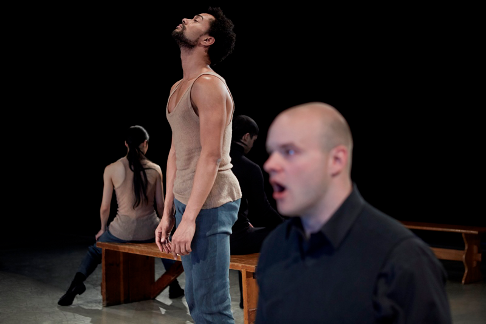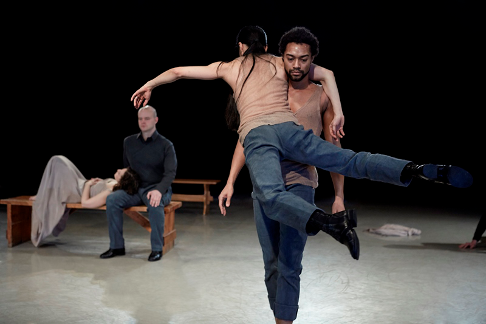Recently in Performances
English Touring Opera are delighted to announce a season of lyric monodramas to tour nationally from October to December. The season features music for solo singer and piano by Argento, Britten, Tippett and Shostakovich with a bold and inventive approach to making opera during social distancing.
This tenth of ten Live from London concerts was in fact a recorded live performance from California. It was no less enjoyable for that, and it was also uplifting to learn that this wasn’t in fact the ‘last’ LfL event that we will be able to enjoy, courtesy of VOCES8 and their fellow vocal ensembles (more below …).
Ever since Wigmore Hall announced their superb series of autumn concerts, all streamed live and available free of charge, I’d been looking forward to this song recital by Ian Bostridge and Imogen Cooper.
Although Stile Antico’s programme article for their Live from London recital introduced their selection from the many treasures of the English Renaissance in the context of the theological debates and upheavals of the Tudor and Elizabethan years, their performance was more evocative of private chamber music than of public liturgy.
Evidently, face masks don’t stifle appreciative “Bravo!”s. And, reducing audience numbers doesn’t lower the volume of such acclamations. For, the audience at Wigmore Hall gave soprano Elizabeth Llewellyn and pianist Simon Lepper a greatly deserved warm reception and hearty response following this lunchtime recital of late-Romantic song.
For this week’s Live from London vocal recital we moved from the home of VOCES8, St Anne and St Agnes in the City of London, to Kings Place, where The Sixteen - who have been associate artists at the venue for some time - presented a programme of music and words bound together by the theme of ‘reflection’.
'Such is your divine Disposation that both you excellently understand, and royally entertaine the Exercise of Musicke.’
‘And there was war in heaven: Michael and his angels fought against the dragon; and the dragon fought and his angels, And prevailed not; neither was their place found any more in heaven … that old serpent … Satan, which deceiveth the whole world: he was cast out into the earth, and his angels were cast out with him.’
There was never any doubt that the fifth of the twelve Met Stars Live in Concert broadcasts was going to be a palpably intense and vivid event, as well as a musically stunning and theatrically enervating experience.
‘Love’ was the theme for this Live from London performance by Apollo5. Given the complexity and diversity of that human emotion, and Apollo5’s reputation for versatility and diverse repertoire, ranging from Renaissance choral music to jazz, from contemporary classical works to popular song, it was no surprise that their programme spanned 500 years and several musical styles.
The Academy of St Martin in the Fields have titled their autumn series of eight concerts - which are taking place at 5pm and 7.30pm on two Saturdays each month at their home venue in Trafalgar Square, and being filmed for streaming the following Thursday - ‘re:connect’.
The London Symphony Orchestra opened their Autumn 2020 season with a homage to Oliver Knussen, who died at the age of 66 in July 2018. The programme traced a national musical lineage through the twentieth century, from Britten to Knussen, on to Mark-Anthony Turnage, and entwining the LSO and Rattle too.
With the Live from London digital vocal festival entering the second half of the series, the festival’s host, VOCES8, returned to their home at St Annes and St Agnes in the City of London to present a sequence of ‘Choral Dances’ - vocal music inspired by dance, embracing diverse genres from the Renaissance madrigal to swing jazz.
Just a few unison string wriggles from the opening of Mozart’s overture to Le nozze di Figaro are enough to make any opera-lover perch on the edge of their seat, in excited anticipation of the drama in music to come, so there could be no other curtain-raiser for this Gala Concert at the Royal Opera House, the latest instalment from ‘their House’ to ‘our houses’.
"Before the ending of the day, creator of all things, we pray that, with your accustomed mercy, you may watch over us."
The doors at The Metropolitan Opera will not open to live audiences until 2021 at the earliest, and the likelihood of normal operatic life resuming in cities around the world looks but a distant dream at present. But, while we may not be invited from our homes into the opera house for some time yet, with its free daily screenings of past productions and its pay-per-view Met Stars Live in Concert series, the Met continues to bring opera into our homes.
Music-making at this year’s Grange Festival Opera may have fallen silent in June and July, but the country house and extensive grounds of The Grange provided an ideal setting for a weekend of twelve specially conceived ‘promenade’ performances encompassing music and dance.
There’s a “slide of harmony” and “all the bones leave your body at that moment and you collapse to the floor, it’s so extraordinary.”
“Music for a while, shall all your cares beguile.”
The hum of bees rising from myriad scented blooms; gentle strains of birdsong; the cheerful chatter of picnickers beside a still lake; decorous thwacks of leather on willow; song and music floating through the warm evening air.
Performances
![Scene from The Tempest Songbook [Photo by Julieta Cervantes]](http://www.operatoday.com/2015-2728_0289.png)
29 Mar 2015
The Tempest Songbook, Gotham Chamber Opera
Gotham Chamber Opera’s latest project, The Tempest Songbook, continues to
explore the possibilities of unconventional spaces and unconventional programs
that the company has made its hallmark. The results were musically and
theatrically thought-provoking, and left me wanting more.
A co-production with
The Martha Graham Dance Company, the evening’s program was directed and
choreographed by Luca Veggetti. The narrative of The Tempest is so
deliberately surrealistic that I found the resistance of narrative in the
program engaging, rather than the reverse. To this Shakespeare aficionado, the
interpolations by Dryden sounded strange, but it was these interpolations that
much of the 1712 incidental music, attributed to Henry Purcell, was designed to
set. The Purcell and Kaija Saariaho‘s
2004 Tempest Songbook for soprano, baritone and period instrument
ensemble intertwined in fascinating ways. In this version, it was receiving its
world premiere, and I loved the textures of harpsichord, recorder, and archlute
(archlute!) in Saariaho’s unconventional harmonies. It was at Saariaho’s
suggestion that the two pieces appeared thus interwoven, and the dialogue
between them was musically rich and intellectually stimulating.

The creative set design was by Jean-Baptiste Barrière. It seems almost a
misnomer to call it minimalist, so richly multivalent was the globe that hung
elegantly suspended by ropes reminiscent of the fated ship’s rigging. Light
projections onto it were skillfully used to evoke globes of the kind so beloved
at the courts of early modern Europe, with seas and continents shifting under
maps of the zodiac, charts of the stars. Images of the singers and dancers also
often appeared there, mirroring and amplifying the action on the stage. The
music of Purcell and Saariaho appeared in alternate sections throughout most of
the evening, with a suite of Saariaho’s songs in the second half of the
hour-long program, which was performed without intermission. From a fairly
straightforward presentation of the initial scenes of The Tempest,
with the panic and anger of the Bosun, and the terror and sorrow of Miranda,
the structure became increasingly impressionistic, with Saariaho’s music
allowing Ariel and Caliban (for instance) much more time than the source
material gives them.
Eight musicians of the Gotham Chamber Opera orchestra played with admirable
verve and versatility under the leadership of Neal Goren. Transitions between
the baroque and the contemporary never felt rough or forced. I enjoyed not only
the brio with which they handled the moods of the Purcell, from ceremonial to
cheerful, but the skill with which they explored the rich and varied textures
of the Saariaho. This was especially notable in the Bosun’s Lament, where the
orchestra musicians echoed the “Roaring, shrieking, howling” of the spirits
described by the increasingly desperate seaman. As we moved to Prospero’s
isle, the dancers began to take turns in center stage, sometimes mirroring the
movements of the singers, sometimes giving bodily expression (with skill that
took my breath away) to the emotions they voiced. In acting for Ariel and
Caliban, respectively, Peiju Chien-Pott and Abdiel Jacobsen gave performances
of extraordinary intensity.

Soprano Jennifer Zetlan and
bass-baritone Thomas
Richards faced the challenges not only of singing music in two very
different styles, but of voicing a diverse array of characters: Prospero and
Miranda; Ariel and Caliban; the bosun and the god of the sea. Zetlan handled
the vocal lines and the emotional arc of Miranda’s Lament (Saariaho) well,
but it was as the sprite Ariel that she really shone, both in the magnificent
self-declaration (combining several of the speeches to Prospero) and the
exquisite “Full fathom five...”, which was the penultimate section of the
program. This was my first time hearing Thomas Richards, and I was very
favorably impressed both by his stage presence and by his full-voiced, plangent
singing. He sang both the Saariaho and the Purcell with great expressivity. My
Musicologist Roommate, who accompanied me, wanted more ornamentation, but
Richards made very fine use of vocal coloring. Saariaho’s setting of
Caliban’s Dream I thought especially lovely. In a traditional production of
Shakespeare’s play, the optimistic concluding ensemble (recording here) would seem strangely inopportune,
but here, it seemed only fitting. The program will be given two
more performances in this run, and could provide an interesting addition to
the repertoire of small companies.
This review first appeared at Opera Obsession. It is reprinted with permission of the author.
![Scene from The Tempest Songbook [Photo by Julieta Cervantes]](http://www.operatoday.com/2015-2728_0289.png)

